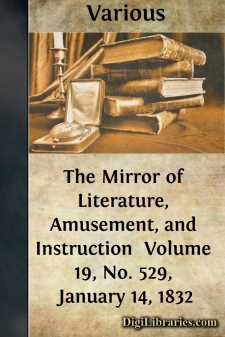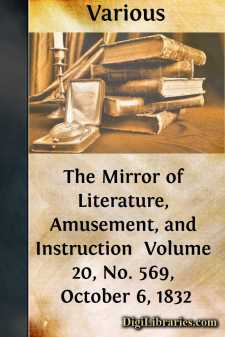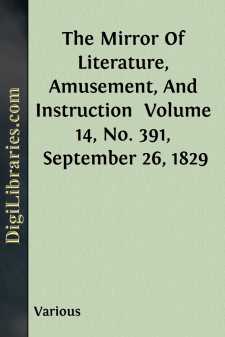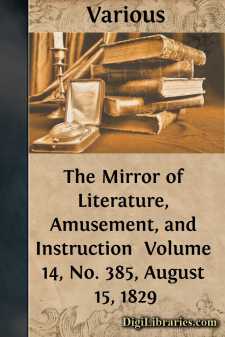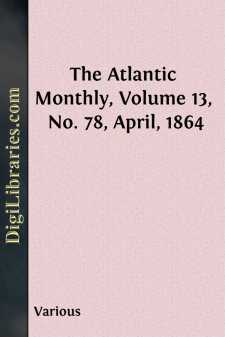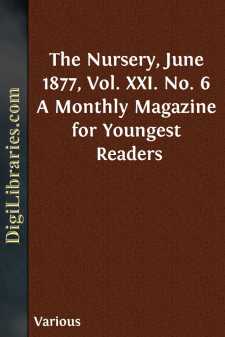Periodicals
- Art 27
- Children's periodicals 59
- Entertainment 5
- Food/Wine 2
- Games/Humor 455
- General
- Health 1
- History 53
- House/Home 1
- Regional 62
- Science/Nature 118
- Transportation 10
General Books
Sort by:
by:
William Curtis
Colutea Frutescens. Scarlet Bladder Senna. Class and Order. Diadelphia Decandria. Generic Character. Cal. 5-fidus. Legumen inflatum, basi superiore dehiscens. Specific Character and Synonyms. COLUTEA frutescens fruticosa, foliolis ovato-oblongis. Linn. Syst. Vegetab. ed. 14. Murr, p. 668. Ait. Hort. Kew. V. 3. p. 56. Mill. Icon. 99. COLUTEA æthiopica, flore purpureo. Breyn. Cent. 70. t. 29. N181.Of...
more...
by:
Various
FISHMONGER'S HALL FISHMONGERS' HALL. ARMS OF THE COMPANY. These Cuts may be welcome illustrations of the olden magnificence of the City of London. The first represents the river or back front of the Hall of the Fishmongers' Company: the second cut, the arms of the Company, is added by way of an illustrative pendent. These insignia are placed over the entrance to the Hall in Lower...
more...
by:
Various
SECOND PAPER. Having, in the preceding paper, described the general organization of an army, we proceed to give a succinct account of some of the principal staff departments, in their relations to the troops. Army organization—notwithstanding the world has always been engaged in military enterprises—is of comparatively recent institution. Many of the principles of existing military systems date no...
more...
by:
Various
LISBON. LISBON. Lisbon, the capital of Portugal, was called by the ancients Ulyssippo, and the foundation is fabulously ascribed to Ulysses. The situation is grand, on the north bank of the river Tagus, in lat. 38° 42-1/3′ N., lon. 9° 8-1/3′ W. The harbour, or rather road, of Lisbon, is one of the finest in the world; and the quays are at once convenient and beautiful. On entering the river, and...
more...
by:
Various
LINCOLN'S ELECTION TO THE TENTH ASSEMBLY.—ADMISSION TO THE BAR.— REMOVAL TO SPRINGFIELD. HE first twenty-six years of Abraham Lincoln's life have been traced in the preceding chapters. We have seen him struggling to escape from the lot of a common farm laborer, to which he seemed to be born; becoming a flatboatman, a grocery clerk, a store-keeper, a postmaster, and finally a surveyor. We...
more...
by:
Various
MR. GURNEY'S IMPROVED STEAM CARRIAGE. Mr. Gurney, in perfecting this invention, has followed Dr. Franklin's advice—to tire and begin again. It is now four years since he first commenced his ingenious enterprise; and nearly two years since we reported and illustrated the progress he had made. (See MIRROR, vol. x. page 393, or No. 287.) He began with a large boiler, but public prejudice was...
more...
by:
Various
HAMPTON COURT. Here is a bird's-eye view of a royal palace and domain "cut out in little stars." It is copied from one of Kipp's Views in Great Britain in the time of Queen Anne, and affords a correct idea of Hampton Court in all its olden splendour. The palace is situated on the north bank of the Thames, two miles west from Kingston. It was magnificently built by Cardinal Wolsey....
more...
by:
Various
Half a dozen rivulets leap down the western declivity of the Rocky Mountains, and unite; four thousand miles away the mighty Missouri debouches into the Mexican Gulf as the result of that junction. Did the rivulets propose or plan the river? Not at all; but they knew, each, its private need to find a lower level; the universal law they obeyed accomplished the rest. So is it with the great human...
more...
by:
Various
FIGHTING FACTS FOR FOGIES. Young people are often charged with caring little for the past. The charge is just; and the young are right. If they care little for the past, then it is certain that it is in debt to them,—as for them the past cared nothing. It is wonderful, considering how children used to be treated, that the human race ever succeeded in getting established on earth. Humanity should have...
more...
by:
Various
ARTHUR'S NEW SLOOP. OW, boys," said Uncle Martin, "if you were at sea in a vessel like this, what should you do when you saw a squall coming up?""I should take in all sail, and scud under bare poles," said Arthur. "But what if you did not want to be blown ashore?" "Then I should leave out the first reef, so as to catch as much wind as I could risk, and steer for the...
more...



